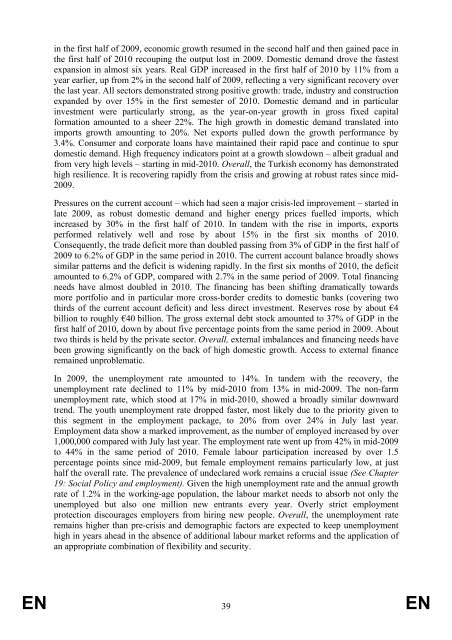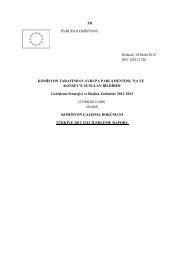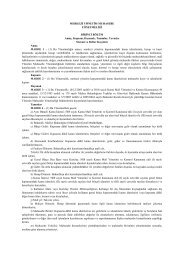2010 ilerleme raporu - Avrupa Birliği Bakanlığı
2010 ilerleme raporu - Avrupa Birliği Bakanlığı
2010 ilerleme raporu - Avrupa Birliği Bakanlığı
Create successful ePaper yourself
Turn your PDF publications into a flip-book with our unique Google optimized e-Paper software.
in the first half of 2009, economic growth resumed in the second half and then gained pace inthe first half of <strong>2010</strong> recouping the output lost in 2009. Domestic demand drove the fastestexpansion in almost six years. Real GDP increased in the first half of <strong>2010</strong> by 11% from ayear earlier, up from 2% in the second half of 2009, reflecting a very significant recovery overthe last year. All sectors demonstrated strong positive growth: trade, industry and constructionexpanded by over 15% in the first semester of <strong>2010</strong>. Domestic demand and in particularinvestment were particularly strong, as the year-on-year growth in gross fixed capitalformation amounted to a sheer 22%. The high growth in domestic demand translated intoimports growth amounting to 20%. Net exports pulled down the growth performance by3.4%. Consumer and corporate loans have maintained their rapid pace and continue to spurdomestic demand. High frequency indicators point at a growth slowdown – albeit gradual andfrom very high levels – starting in mid-<strong>2010</strong>. Overall, the Turkish economy has demonstratedhigh resilience. It is recovering rapidly from the crisis and growing at robust rates since mid-2009.Pressures on the current account – which had seen a major crisis-led improvement – started inlate 2009, as robust domestic demand and higher energy prices fuelled imports, whichincreased by 30% in the first half of <strong>2010</strong>. In tandem with the rise in imports, exportsperformed relatively well and rose by about 15% in the first six months of <strong>2010</strong>.Consequently, the trade deficit more than doubled passing from 3% of GDP in the first half of2009 to 6.2% of GDP in the same period in <strong>2010</strong>. The current account balance broadly showssimilar patterns and the deficit is widening rapidly. In the first six months of <strong>2010</strong>, the deficitamounted to 6.2% of GDP, compared with 2.7% in the same period of 2009. Total financingneeds have almost doubled in <strong>2010</strong>. The financing has been shifting dramatically towardsmore portfolio and in particular more cross-border credits to domestic banks (covering twothirds of the current account deficit) and less direct investment. Reserves rose by about €4billion to roughly €40 billion. The gross external debt stock amounted to 37% of GDP in thefirst half of <strong>2010</strong>, down by about five percentage points from the same period in 2009. Abouttwo thirds is held by the private sector. Overall, external imbalances and financing needs havebeen growing significantly on the back of high domestic growth. Access to external financeremained unproblematic.In 2009, the unemployment rate amounted to 14%. In tandem with the recovery, theunemployment rate declined to 11% by mid-<strong>2010</strong> from 13% in mid-2009. The non-farmunemployment rate, which stood at 17% in mid-<strong>2010</strong>, showed a broadly similar downwardtrend. The youth unemployment rate dropped faster, most likely due to the priority given tothis segment in the employment package, to 20% from over 24% in July last year.Employment data show a marked improvement, as the number of employed increased by over1,000,000 compared with July last year. The employment rate went up from 42% in mid-2009to 44% in the same period of <strong>2010</strong>. Female labour participation increased by over 1.5percentage points since mid-2009, but female employment remains particularly low, at justhalf the overall rate. The prevalence of undeclared work remains a crucial issue (See Chapter19: Social Policy and employment). Given the high unemployment rate and the annual growthrate of 1.2% in the working-age population, the labour market needs to absorb not only theunemployed but also one million new entrants every year. Overly strict employmentprotection discourages employers from hiring new people. Overall, the unemployment rateremains higher than pre-crisis and demographic factors are expected to keep unemploymenthigh in years ahead in the absence of additional labour market reforms and the application ofan appropriate combination of flexibility and security.EN 39 EN
















